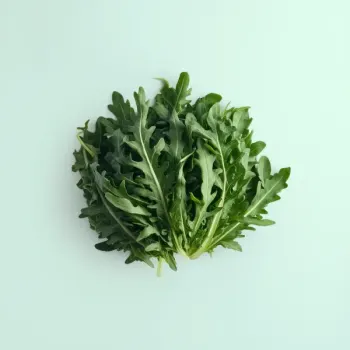Arugula and Frisee are leafy greens with unique flavors and textures used in cooking. Arugula is peppery and great for salads and as a pizza topping, while Frisee has a mild bitterness, perfect for substantial salads and adding crispness to sandwiches. Both are nutritious, low-calorie additions to meals.

Arugula, also known as rocket, is a peppery, slightly tangy leafy green commonly used in salads, as a pizza topping, or as a garnish. It's part of the Brassicaceae family, which includes broccoli and kale.

Frisee is a type of chicory with frilly, pale green leaves and a slightly bitter taste. It's often found in mesclun mixes and is beloved for its unique texture and ability to pair well with sweet and savory dressings.
Arugula and Frisee differ mainly in taste and texture. Arugula has a peppery, bold flavor and tender leaves, while Frisee offers a more subtle bitterness with a crisp, almost fluffy texture. Arugula is a younger plant, harvested early in its growth cycle, whereas Frisee is a mature chicory variety.

Your ultimate Recipe Box, Meal Planner, and Cooking Class all in one
Arugula shines in salads such as a simple lemon and Parmesan salad, where its peppery bite complements the salty cheese and tangy citrus. It wilts quickly, so dress it right before serving for the best texture. Frisee is ideal for more substantial salads like the classic French frisee salad with lardons and poached eggs. Its crispness holds up well against warm dressings and hearty ingredients.
Use arugula in sandwiches and wraps that benefit from a spicy kick, such as a roast beef and arugula sandwich with horseradish mayo. Its soft leaves provide a pleasant contrast to crusty bread and crunchy vegetables. Frisee can be used in sandwiches that need a mild, bitter edge and a crispy texture. Try it in a classic club sandwich or a vegetable wrap to add volume without overpowering other flavors.
Top your pizza with fresh arugula after baking for a peppery, fresh element. It pairs well with prosciutto and goat cheese pizzas, adding a fresh counterbalance to the rich and savory toppings. While less common, frisee can be used on pizzas that feature sweeter components like figs or caramelized onions, where its light bitterness complements the sweetness and adds a unique texture.
Both Arugula and Frisee are low in calories and rich in vitamins and minerals, making them a healthy addition to any meal.
| Nutrient | Frisee ( per Cup ) | Arugula ( per Cup ) |
|---|---|---|
| Fat | 0.2g | 0.1g |
| Sodium | 4mg | 6mg |
| Calcium | 8mg | 32mg |
| Protein | 1g | 0.5g |
| Calories | 17 | 5 |
| Carbohydrates | 3g | 0.7g |
It depends on the type of salad and desired flavor profile. Arugula's peppery taste is great for simple, bold salads, while frisee's mild bitterness suits hearty salads with rich dressings.
Arugula can be lightly sautéed or wilted, while Frisee is generally best served fresh to preserve its crisp texture.
Both should be stored in the refrigerator. Keep Arugula in a breathable bag and Frisee in its original packaging or a sealed container with a damp paper towel.
They can be substituted for each other to some degree, but expect changes in flavor and texture. Arugula is spicier and softer, while Frisee is milder and crispier.
Arugula and Frisee are both low in calories and contain essential nutrients like vitamins A and K, calcium, and iron, supporting overall health.